November 27, 2025 | 16:09 GMT +7
November 27, 2025 | 16:09 GMT +7
Hotline: 0913.378.918
November 27, 2025 | 16:09 GMT +7
Hotline: 0913.378.918
Nowadays, by-products, waste, and organic household waste from production and daily activities are considered valuable resources, a "gold mine" that can be exploited to generate income. Recently, farmers in Thanh Thoi A commune, Mo Cay Nam district, Ben Tre province shared with us a model of recycling waste into money.

Calcium worms sold for VND 40,000/kg. Photo: Minh Dam.
Mr. Nguyen Thanh Tuan, Chairman of the Farmers' Association of Thanh Thoi A commune and a farmer who has implemented a model of recycling waste into money, shared: In the local area, there are more than 10 households raising calcium worms and 20 households raising earthworms effectively by utilizing household waste, restaurant waste, and livestock waste. Many households raise both calcium worms and earthworms. This has increased income for farming households, utilized idle labour, and reduced environmental pollution caused by livestock activities.
This is also an initial achievement of the project “Propagating and mobilizing farmers to handle waste in Vietnam, contributing to the international community's effort to reduce greenhouse gas emissions” launched by the Central Farmers' Association of Vietnam in the commune.
Mr Nguyen Thanh Tuan said: Organic waste such as leftover food from families and restaurants, coconut husks, soybean residue, thinly sliced banana trees, dead animal carcasses, and livestock manure... are all favourite foods for calcium worms (the larvae of the black soldier fly) and earthworms.
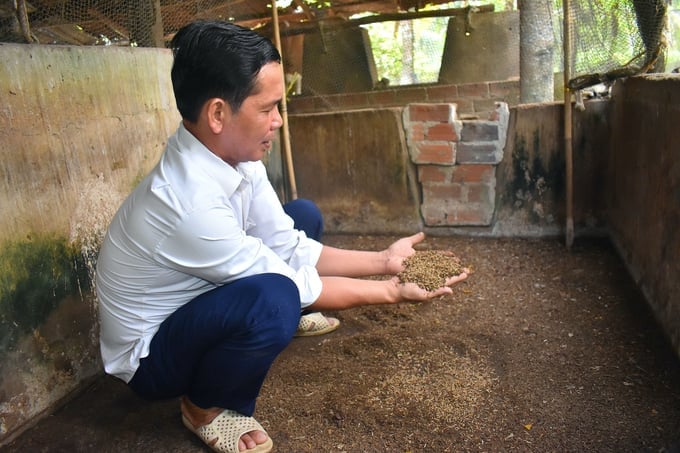
Mr. Nguyen Thanh Tuan, Chairman of the Farmers' Association of Thanh Thoi A commune, inspecting calcium worm pupae for harvest. Photo: Minh Dam.
The products obtained include organic fertilizer and pupae (from the calcium worm farming model) and earthworm meat (from the earthworm farming model). The harvested pupae and earthworm meat can be used as feed for fish, chickens, and ducks. The organic fertilizer can be used for coconut trees, fruit trees, ornamental plants, and vegetables as a substitute for chemical fertilizers. If not used by the farmers themselves, these products can be sold to increase income.
Mr Tuan led us to the back of his house, where the relatively small livestock area is located about 20-30 steps away. Currently, his family is raising three cows and some chickens and ducks. Closest to the house is the calcium worm farming area, followed by the earthworm farming area.
The calcium worm farming area measures 2.5 meters in length, 1.5 meters in width, and 25 centimetres in height. This space is suitable for raising 25-50 grams of black soldier fly eggs. However, a lower density helps the worms develop better. The farming area is enclosed with mesh netting.
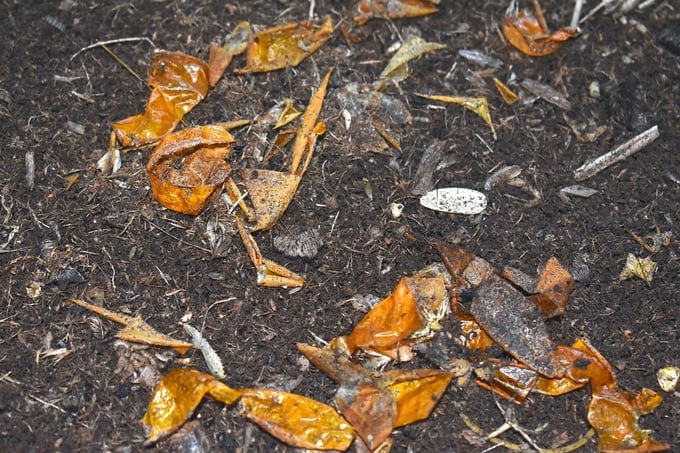
Calcium worms and earthworms feed on spoiled fruits and vegetables, animal carcasses, livestock manure, and more, helping to address environmental pollution. Photo: Minh Dam.
Black soldier fly eggs are incubated in a secluded place for 2 days until they hatch into larvae. They are then nurtured on small trays for about 7 days. After this period, they are released into a rearing area for an additional 4-5 days before the nutritious young larvae can be harvested for animal feed or commercial sale. If farmers wish to breed them, they can allow the larvae to develop into pupae, which will metamorphose into adult black soldier flies by the 20th day. These adult flies will then mate, starting a new lifecycle.
"Raising 50 grams of fly eggs can yield 80-100 kilograms of larvae. One kilogram of larvae sells for around VND 30-40 thousand. After deducting the cost of eggs and care expenses, the profit can be VND 1.5-2 million per half-month breeding cycle", Mr Tuan shared.
He further explained that the larvae are commonly purchased as food for ornamental birds and fighting chickens. Therefore, buyers prefer plump, white larvae. The key to achieving white larvae lies in the diet. If the larvae are fed rice, leftover soup, soybean residue, coconut pulp, chopped banana trees, and spoiled vegetables, they will be white. Conversely, if their diet consists of cow or pig manure, they will have a darker colour. Some customers may mistake this darker hue for old (less nutritious) larvae and choose not to buy them. "Depending on the farming purpose, you should select appropriate food for the larvae", Mr. Tuan emphasized.
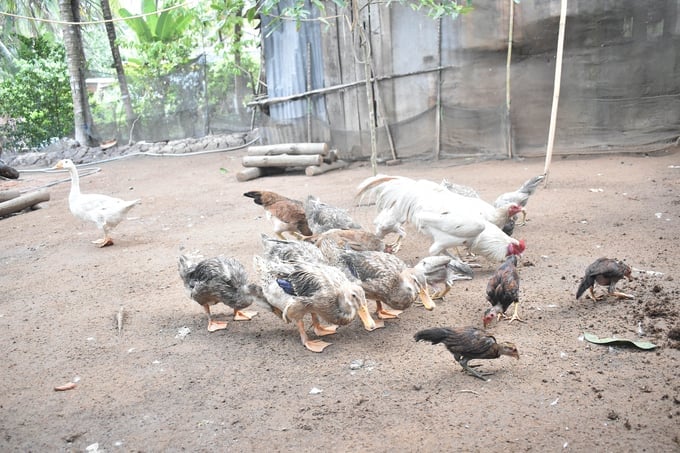
Using calcium larvae, farmers raise chickens and ducks to increase their income. Photo: Minh Dam.
In addition to calcium-rich larvae, livestock farmers also choose black soldier fly larvae to treat waste, reduce environmental pollution, and increase income as black soldier fly larvae belong to the group of feces-eating larvae. Mature black soldier fly larvae are very rich in protein. The dry matter content in black soldier fly larvae accounts for 15 - 20%, of which the protein content is up to 70%. This is a high-quality and inexpensive feed for livestock. Raising black soldier fly larvae also does not require too much space and time for care.
To raise black soldier fly larvae, it is necessary to prepare a solid pen with a roof. Depending on the demand, build a suitable pen area. The pen floor should be concrete. The pen needs to maintain humidity at 75 – 80%, and temperature from 20 – 28 degrees Celsius, and water should be sprayed 1 – 2 times a day. During the raising process, if there are natural enemies such as ants, frogs, birds, or mice, it is necessary to prevent and eliminate them thoroughly, especially by using protective nets. The black soldier fly larvae farming technique is meticulously trained by the Ben Tre Farmers' Association before providing breeding stock to farmers.
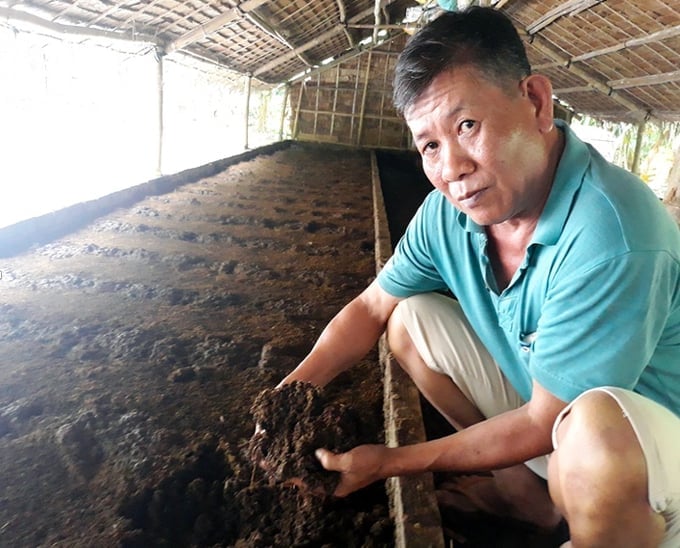
Raising black soldier fly larvae helps to solve the environmental pollution problem caused by livestock waste. Photo: Minh Dam.
Mr Truong Van Quan's family in Thanh Long hamlet, Thanh Thoi A commune, after participating in the training course, boldly invested in building a black soldier fly larvae and calcium-rich larvae farm. According to Mr Quan, initially, the black soldier fly larvae farming model solved the amount of waste produced by the cattle every day, so there is no longer environmental pollution as before.
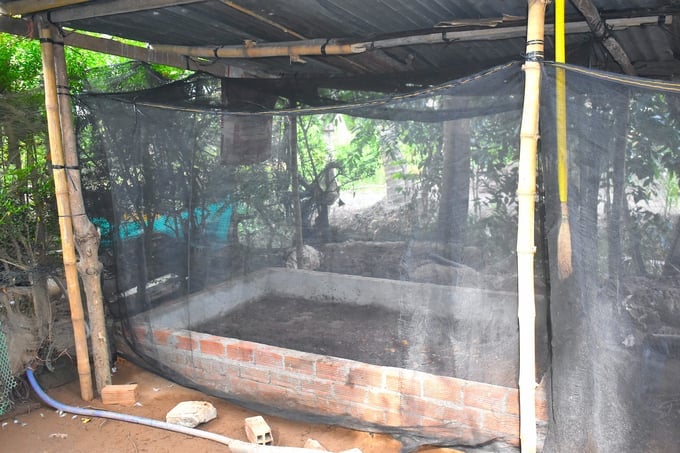
Covering the area for raising calcium-rich larvae with mosquito nets. Photo: Minh Dam.
Mr. Nguyen Van Net, residing in Tan Phong hamlet (Thanh Thoi A commune), is also one of the pioneering households in the black soldier fly larvae farming movement.
Ben Tre province has a fairly developed livestock sector with over 218 thousand cattle, nearly 380 thousand pigs, and over 6.1 million poultry. Recently, waste treatment activities to prevent environmental pollution as well as efficient exploitation of this "gold mine" have been receiving considerable attention from local authorities and people. Many waste treatment models are being effectively applied by farmers, such as biogas digesters, organic fertilizer composting...
Translated by Hoang Duy

(VAN) China’s cooking oil is suddenly flooding into India. It all comes down to a soybean surplus that Beijing doesn’t quite know what to do with.

(VAN) An Giang promotes supply-demand connections, standardizes quality and builds value chains, creating a foundation for sustainable bird’s nest development and aiming to expand exports.
/2025/11/24/5339-4-nongnghiep-075331.jpg)
(VAN) Recently, the conference on 'Sustainable Fisheries Linkage Chain - Tilapia for Export' took place in Tien Hai commune, Hung Yen province.
/2025/11/21/4309-2-153400_128.jpg)
(VAN) Green and low-emission rice is paving the way for Vietnamese rice to enter high-end markets, marking the beginning of a transformation journey toward greening and elevating the national rice brand.

(VAN) ‘Right to Win’ outlines a national action plan that shapes a new vision for Viet Nam’s agriculture in an era of renewal and global integration.

(VAN) Lam Dong’s farmed sturgeon output this year is expected to reach 2,300 tons, worth VND 450 billion, affirming the brand’s position on the market.

(VAN) A surge in Ukrainian egg exports, largely driven by soaring sales to the UK over the last few years, has notably pushed up egg prices on the domestic market.